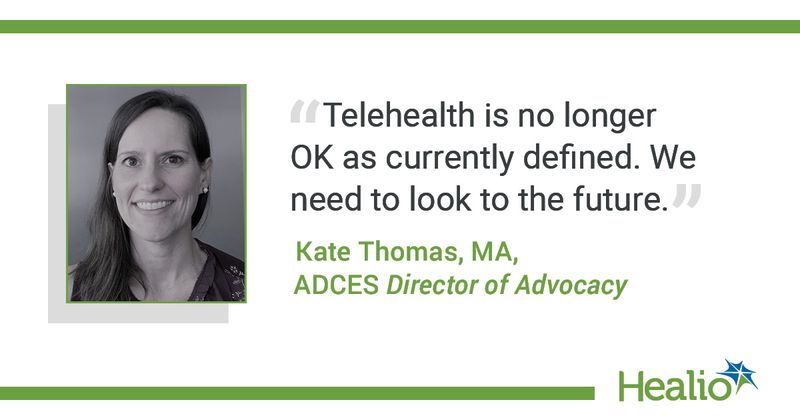Updated CMS guidance adds DSMT services to eligible telehealth providers
CMS has updated guidance to clarify that all accredited diabetes self-management training providers may furnish and bill for telehealth services during the COVID-19 public health emergency, after months of stakeholder advocacy efforts.
The change means that providers of diabetes self-management education training, or DSMT, are eligible to bill Medicare Part B directly for telehealth services during the pandemic, increasing access to diabetes self-management education and support services for people with diabetes who need it.

Adding DSMT programs to the list of eligible providers of telehealth services removes the final regulatory barriers preventing registered nurses and pharmacists from furnishing DSMT services via telehealth, according to the Association of Diabetes Care & Education Specialists (ADCES), an organization that has closely monitored the changes. ADCES updated members of the change on its website Aug. 12.
Healio spoke with Kate Thomas, MA, ADCES director of advocacy, about what the guidance means for registered nurses and pharmacists, efforts to make the change permanent after the pandemic and how diabetes care and education specialists can use telehealth to address COVID-19-specific needs in diabetes.
What did ADCES advocate for this change, and what does this CMS clarification mean for diabetes care and education specialists?
Thomas: At the start of the pandemic, as everyone started to transition to telehealth, DSMT programs were still facing limitations because CMS has a narrow list of eligible providers who can provide telehealth. We repeatedly asked CMS about DSMT programs. Registered dieticians were on the list, but no other diabetes care and education specialists were. That was a real issue for our program. So, we launched an advocacy campaign to make sure we could add pharmacists and registered nurses to the list of eligible providers.
Then, we changed our strategy to focus on the DSMT program, because all of the billing is done at the DSMT program level. We advocated CMS to add the DSMT programs as eligible telehealth providers. CMS acted in April and responded to our advocacy, addressing this issue in the hospital outpatient setting. But, that left the independent pharmacies and the provider practices led by pharmacists and nurses high and dry on the telehealth side. We continued our advocacy along with other organizations. Finally, they made the change. Now, all DSMT programs can offer telehealth.
What took so long for CMS to make this change?
Thomas: In the realm of regulatory changes, CMS acted pretty quickly. I do not make light of the fact that this was a serious barrier, but they acted as quickly as they could. Before the CARES act was passed, CMS did not have the regulatory authority to change the list of eligible telehealth providers. They may have thought they addressed this issue in April, but it was not clear enough. There was a lot of bureaucracy.
This updated guidance is only in effect during the COVID-19 public health emergency. Is a goal going forward to make this updated guidance permanent, and what other telehealth-related changes would ADCES like to see?
Thomas: Absolutely. We already submitted comments to CMS. We are working with Congress. We are working with a number of coalitions to pushing for permanent changes. We have a call to action on our website listing our long-term priorities. Those include expanding the list of eligible telehealth providers; reimbursement parity, so telehealth services are reimbursed at the same rate as in-person visits; removing the originating and geographic site requirement so beneficiaries can still access the services in their home. Now is a point of reckoning for Congress to say, “We need to update the law.” Telehealth is no longer OK as currently defined. We need to look to the future.
How are diabetes care and education specialists using telehealth to help people with diabetes during the COVID-19 pandemic?
Thomas: We see the data about the impact of COVID-19 on people with diabetes. This does not just affect outcomes; the pandemic created a massive disruption to daily life. Diabetes care and education specialists can help people with diabetes who had to alter their routines. How are you getting your physical activity? How are you managing if you do not have as much access to food or can’t get to a grocery store? There are medication management changes and a need to manage the overall stress of the pandemic. As we are looking at lifestyle changes in the face of this pandemic, these and many other issues are where diabetes care and education specialists — that interdisciplinary team — come in.
Reference
- CMS Removes Restrictions Around RNs and Pharmacists Furnishing DSMT via Telehealth. Available at: www.diabeteseducator.org/news/perspectives/aade-blog-details/adces-perspectives-on-diabetes-care/2020/08/12/cms-removes-restrictions-around-rns-and-pharmacists-furnishing-dsmt-via-telehealth. Accessed: Aug. 13, 2020.

